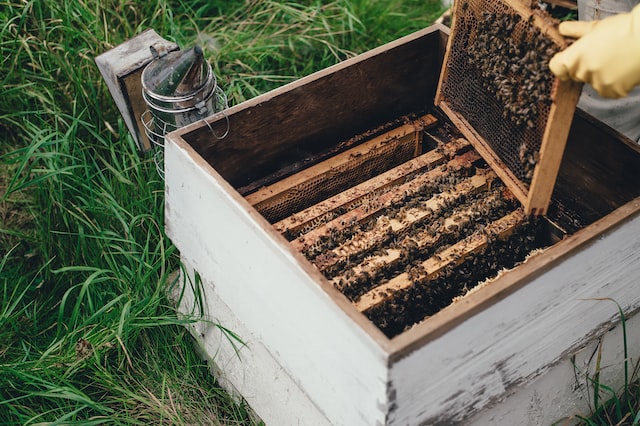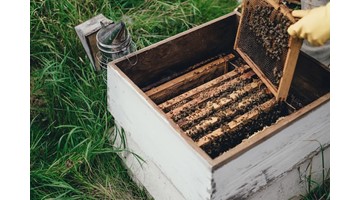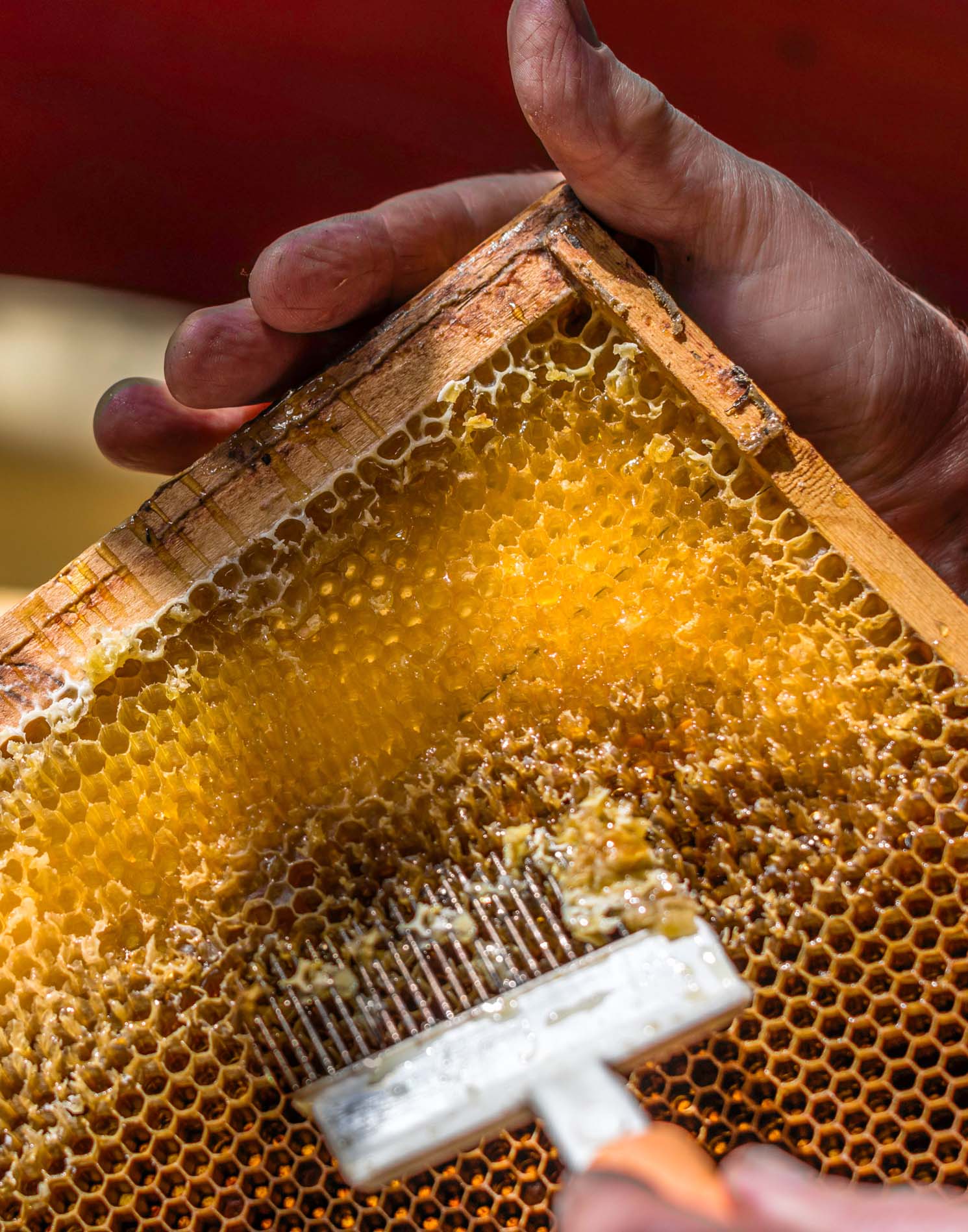Beekeepers’ tasks in March

Beekeepers’ tasks in beginning of spring
March is the first spring month. Tired of gray, cold, and short winter days, we look forward to the first warm rays of sun. Bees are getting more active every day because nature is waking up, and there is more and more food for them. The first flowers of spring start blooming, which attract bees out of hives on sunny days. It is a real pleasure to watch them bring in whole chunks of yellow pollen to the hives.
March is usually still cold enough that we can only perform the most essential tasks with bees, and even for those, we have to wait for the temperature to rise to at least 10°C in the shade. We perform the first inspections very quickly, being careful not to lose too much heat from the hive and not to disturb the bee colonies too much. When inspecting multi-chamber Langstroth hives, we use their advantages by lifting the bottom board from the back and immediately determine how much food the family still has. Before opening the hive, we remove the roof and lay it upside down on the neighboring hive, so we can use it as a convenient workbench, and blow smoke through the cover opening. We never smoke through the bottom entrance because it would drive away the guard bees and thus allow foreign bees to invade the hive. With a hive tool, we lift the cover, clean the wax frames, and smoke the bees again. An experienced beekeeper can tell the condition of the bee family just by looking from the top.
In the autumn, before the families are prepared for winter, we remove the side frame for better ventilation. This makes shifting or flipping frames quick and precise. Without crushing the bees, we determine the number of frames with brood, the strength of the family, etc. At this time, we also rearrange the bee nest in the hive. We move the nest to the center of the hive body, making sure that bees have access to food from both sides in bad weather. This action makes it easier for bees to regulate the temperature and has a favorable effect on spring development. When relocating the bee nest, we can tear off the honey cappings on honey frames. If we are wintering in two chambers, and the bee colony occupies only a smaller space in one hive body, we remove the unoccupied chamber. This also makes it easier for bees to regulate the temperature, which has a favorable effect on spring development.
Moving a Bee Colony
First, we look at the hives that we marked as suspicious on the day of the cleansing flight and the hives where we found a lack of food when replacing the bottom boards. The first major food consumption begins now that the brood circle is expanding. During this month, colonies consume approximately 2 kg of food. The colony will develop normally if it has at least 8 kg of food reserves in the frames. Every good beekeeper should always have some honeycombs in stock for winter.
If the queen bee lacks food, she severely limits egg-laying, and the colony does not develop. We add reserve honeycombs with pollen to the hungry and weakened colony and replace them with empty ones. We warm up the honeycombs with food to room temperature before adding them and open them with forks or at least crack them so that the bees can immediately start carrying the honey. The queen bee senses that the bees have collected honey and begins to lay eggs more intensively. Every good beekeeper should always have some honeycombs with pollen in stock for winter. However, if we don't have honeycombs, I recommend a warm sugar solution, but only on warmer days.
From the state of covered brood, we can determine the following:
- If the brood is compact and flat, the queen is good.
- If the brood is scattered and flat, the queen's laying has decreased, which does not ensure progress for the colony.
- If the brood is scattered and bumpy, the queen has become drone-laying. Such a queen has exhausted her sperm, which can cause the colony to fail.
- If the brood is scattered and bumpy, and we notice multiple eggs in individual cells on the comb, it is a laying worker bee. False queens lay in these cells.
During spring inspections, we devote more time to those colonies that did not overwinter normally. In a moderately organized apiary, approximately 10 percent of the colonies die over winter and spring on average. The most common causes of colony death are:
- The old queen has died. Such queenless hives are the first spring prey of bee robbers who take away all their food, causing the colony to die of starvation in the end.
- The colony did not have enough food. Due to late feeding, the queen laid too few winter bees. The cause may also be a silent robbery that happened in the fall when there was no longer an opportunity to check the food supply.
- The colony could not reach the food due to severe short-term frost and improper placement of food outside the winter cluster, and it died of starvation.
- A shrew entered the hive through the bottom board with a too high entrance. Due to unrest, the colony scattered, consumed more food, and died.
- Bees were heavily infested with varroa, and due to the attack of this parasite, they scattered and flew away. As a result, the collapsed hives are empty, without corpses and with plenty of food in the comb. We must start suppressing varroa in the colonies already after July 20, when we extract honey, so that the winter bees that the queen lays during this period remain healthy.
We merge weak or queenless bee colonies with stronger ones. We must press weaker colonies with a queen with a separating wooden frame or board onto five frames, thus reducing the space for heating and making it easier for bees to maintain the microclimate in the hive. Later, we merge these colonies with stronger ones. If we don't have them, we strengthen them with bees and brood from reserve colonies.
In recent years, we have noticed a very high death rate of bee colonies. The collapse is influenced by various factors, such as varroa, unfavorable weather conditions, and nature's toxicity with pesticides, which are toxic to bees. Last year was the year in which all three negative factors combined, so this year we must take care of weakened bee colonies with caution and sensibility. One of the measures is the above-described compression of the colony to the smallest possible space. To maintain the number of colonies, it is advisable to have at least 20 percent reserve colonies in your apiary. These usually overwinter on five to seven frames. Typically, reserve colonies have young queens, so they overwinter better and develop faster in the spring than many normal colonies. In spring, we only use them if a strong colony loses its queen, otherwise we care for them normally, as they will develop much faster than the others.
To accelerate or stimulate development during this period, we can use:
- procedures that do not involve stimulation feeding,
- procedures that involve various forms of feeding stimulation.
The goal of all these procedures is to achieve the maximum development of the bee colony as quickly as possible, so that it can fully exploit the first main nectar flow.
The simplest procedure for accelerating development without feeding stimulation is to use a fork to scrape off or puncture the caps of the honeycomb cells. The bees will immediately start transferring honey, and the queen will sense that there is a nectar flow in nature, which will cause her to start laying eggs more intensively.
The other two typical procedures for hive management are reversing and replacing a chamber. In spring, the bee colony has brood in the warmest southern part of the hive, usually located in front of the entrance, and stores honey in the cooler northern part. We lift and turn the super 180 degrees, so that the brood is now in the cooler part of the hive and the honey is in the warmer part. As the bees move honey from the warmer to the cooler part of the hive, the queen will lay more eggs, resulting in faster development of the bee colony.
Replacing chambers
In the spring, the brood chamber of a beehive contains both brood and some honey and pollen, while the majority of the food is stored in the honey super. If we did not save enough food over the winter to allow the bee colony to survive in the brood chamber alone, we place the honey super beneath the brood chamber, where the bees and brood are located. Bees do not like having honey in front of the entrance, as they instinctively store it above the brood. Thus, they will start carrying honey from the brood chamber to the honey super, above and alongside the brood. In this way, we create conditions similar to those during a good nectar flow, when the queen is laying eggs constantly. By manipulating the chambers and supers in this way, we can also obtain up to 16 frames of brood, while also taking the first step in preventing swarming.
Both of these procedures must be adapted to the development and strength of the bee colony, as well as to the weather conditions. By turning and replacing the chambers, we change the microclimate and quickly increase the volume of the hive. Microclimate refers to the temperature, humidity, and concentration of carbon dioxide and oxygen in the hive. Temperature has the greatest impact on the proper development of bees.
The Importance of Nectar Flow from Willow Trees
If we carry out these stimulating procedures too early, the bee colony will no longer be able to control the microclimate of the hive, and instead of accelerated development, we will achieve the opposite effect, which is the regression of the bee colony. In short, we must be mindful that the correct procedure is used at the right time.
Opinions on spring stimulative feeding with feeding patties or sugar syrup are very divided among beekeepers. If the food supply near the brood nest is rapidly decreasing, and we have no reserve honeycomb, we have no choice but to add food to the bees through stimulative feeding. Many beekeepers prefer to use feeding patties, but we must be careful because the bees need more water to process this food, which can cause many problems during cold and bad weather.
In short, we must provide the bee colony with better living conditions than they have naturally throughout their entire life cycle. This is especially important in March, as this is the only way to ensure accelerated development.
Beekeepers’ tasks in beginning of spring
March is the first spring month. Tired of gray, cold, and short winter days, we look forward to the first warm rays of sun. Bees are getting more active every day because nature is waking up, and there is more and more food for them. The first flowers of spring start blooming, which attract bees out of hives on sunny days. It is a real pleasure to watch them bring in whole chunks of yellow pollen to the hives.
March is usually still cold enough that we can only perform the most essential tasks with bees, and even for those, we have to wait for the temperature to rise to at least 10°C in the shade. We perform the first inspections very quickly, being careful not to lose too much heat from the hive and not to disturb the bee colonies too much. When inspecting multi-chamber Langstroth hives, we use their advantages by lifting the bottom board from the back and immediately determine how much food the family still has. Before opening the hive, we remove the roof and lay it upside down on the neighboring hive, so we can use it as a convenient workbench, and blow smoke through the cover opening. We never smoke through the bottom entrance because it would drive away the guard bees and thus allow foreign bees to invade the hive. With a hive tool, we lift the cover, clean the wax frames, and smoke the bees again. An experienced beekeeper can tell the condition of the bee family just by looking from the top.
In the autumn, before the families are prepared for winter, we remove the side frame for better ventilation. This makes shifting or flipping frames quick and precise. Without crushing the bees, we determine the number of frames with brood, the strength of the family, etc. At this time, we also rearrange the bee nest in the hive. We move the nest to the center of the hive body, making sure that bees have access to food from both sides in bad weather. This action makes it easier for bees to regulate the temperature and has a favorable effect on spring development. When relocating the bee nest, we can tear off the honey cappings on honey frames. If we are wintering in two chambers, and the bee colony occupies only a smaller space in one hive body, we remove the unoccupied chamber. This also makes it easier for bees to regulate the temperature, which has a favorable effect on spring development.
Moving a Bee Colony
First, we look at the hives that we marked as suspicious on the day of the cleansing flight and the hives where we found a lack of food when replacing the bottom boards. The first major food consumption begins now that the brood circle is expanding. During this month, colonies consume approximately 2 kg of food. The colony will develop normally if it has at least 8 kg of food reserves in the frames. Every good beekeeper should always have some honeycombs in stock for winter.
If the queen bee lacks food, she severely limits egg-laying, and the colony does not develop. We add reserve honeycombs with pollen to the hungry and weakened colony and replace them with empty ones. We warm up the honeycombs with food to room temperature before adding them and open them with forks or at least crack them so that the bees can immediately start carrying the honey. The queen bee senses that the bees have collected honey and begins to lay eggs more intensively. Every good beekeeper should always have some honeycombs with pollen in stock for winter. However, if we don't have honeycombs, I recommend a warm sugar solution, but only on warmer days.
From the state of covered brood, we can determine the following:
- If the brood is compact and flat, the queen is good.
- If the brood is scattered and flat, the queen's laying has decreased, which does not ensure progress for the colony.
- If the brood is scattered and bumpy, the queen has become drone-laying. Such a queen has exhausted her sperm, which can cause the colony to fail.
- If the brood is scattered and bumpy, and we notice multiple eggs in individual cells on the comb, it is a laying worker bee. False queens lay in these cells.
During spring inspections, we devote more time to those colonies that did not overwinter normally. In a moderately organized apiary, approximately 10 percent of the colonies die over winter and spring on average. The most common causes of colony death are:
- The old queen has died. Such queenless hives are the first spring prey of bee robbers who take away all their food, causing the colony to die of starvation in the end.
- The colony did not have enough food. Due to late feeding, the queen laid too few winter bees. The cause may also be a silent robbery that happened in the fall when there was no longer an opportunity to check the food supply.
- The colony could not reach the food due to severe short-term frost and improper placement of food outside the winter cluster, and it died of starvation.
- A shrew entered the hive through the bottom board with a too high entrance. Due to unrest, the colony scattered, consumed more food, and died.
- Bees were heavily infested with varroa, and due to the attack of this parasite, they scattered and flew away. As a result, the collapsed hives are empty, without corpses and with plenty of food in the comb. We must start suppressing varroa in the colonies already after July 20, when we extract honey, so that the winter bees that the queen lays during this period remain healthy.
We merge weak or queenless bee colonies with stronger ones. We must press weaker colonies with a queen with a separating wooden frame or board onto five frames, thus reducing the space for heating and making it easier for bees to maintain the microclimate in the hive. Later, we merge these colonies with stronger ones. If we don't have them, we strengthen them with bees and brood from reserve colonies.
In recent years, we have noticed a very high death rate of bee colonies. The collapse is influenced by various factors, such as varroa, unfavorable weather conditions, and nature's toxicity with pesticides, which are toxic to bees. Last year was the year in which all three negative factors combined, so this year we must take care of weakened bee colonies with caution and sensibility. One of the measures is the above-described compression of the colony to the smallest possible space. To maintain the number of colonies, it is advisable to have at least 20 percent reserve colonies in your apiary. These usually overwinter on five to seven frames. Typically, reserve colonies have young queens, so they overwinter better and develop faster in the spring than many normal colonies. In spring, we only use them if a strong colony loses its queen, otherwise we care for them normally, as they will develop much faster than the others.
To accelerate or stimulate development during this period, we can use:
- procedures that do not involve stimulation feeding,
- procedures that involve various forms of feeding stimulation.
The goal of all these procedures is to achieve the maximum development of the bee colony as quickly as possible, so that it can fully exploit the first main nectar flow.
The simplest procedure for accelerating development without feeding stimulation is to use a fork to scrape off or puncture the caps of the honeycomb cells. The bees will immediately start transferring honey, and the queen will sense that there is a nectar flow in nature, which will cause her to start laying eggs more intensively.
The other two typical procedures for hive management are reversing and replacing a chamber. In spring, the bee colony has brood in the warmest southern part of the hive, usually located in front of the entrance, and stores honey in the cooler northern part. We lift and turn the super 180 degrees, so that the brood is now in the cooler part of the hive and the honey is in the warmer part. As the bees move honey from the warmer to the cooler part of the hive, the queen will lay more eggs, resulting in faster development of the bee colony.
Replacing chambers
In the spring, the brood chamber of a beehive contains both brood and some honey and pollen, while the majority of the food is stored in the honey super. If we did not save enough food over the winter to allow the bee colony to survive in the brood chamber alone, we place the honey super beneath the brood chamber, where the bees and brood are located. Bees do not like having honey in front of the entrance, as they instinctively store it above the brood. Thus, they will start carrying honey from the brood chamber to the honey super, above and alongside the brood. In this way, we create conditions similar to those during a good nectar flow, when the queen is laying eggs constantly. By manipulating the chambers and supers in this way, we can also obtain up to 16 frames of brood, while also taking the first step in preventing swarming.
Both of these procedures must be adapted to the development and strength of the bee colony, as well as to the weather conditions. By turning and replacing the chambers, we change the microclimate and quickly increase the volume of the hive. Microclimate refers to the temperature, humidity, and concentration of carbon dioxide and oxygen in the hive. Temperature has the greatest impact on the proper development of bees.
The Importance of Nectar Flow from Willow Trees
If we carry out these stimulating procedures too early, the bee colony will no longer be able to control the microclimate of the hive, and instead of accelerated development, we will achieve the opposite effect, which is the regression of the bee colony. In short, we must be mindful that the correct procedure is used at the right time.
Opinions on spring stimulative feeding with feeding patties or sugar syrup are very divided among beekeepers. If the food supply near the brood nest is rapidly decreasing, and we have no reserve honeycomb, we have no choice but to add food to the bees through stimulative feeding. Many beekeepers prefer to use feeding patties, but we must be careful because the bees need more water to process this food, which can cause many problems during cold and bad weather.
In short, we must provide the bee colony with better living conditions than they have naturally throughout their entire life cycle. This is especially important in March, as this is the only way to ensure accelerated development.
Author: Vlado Auguštin, Source



